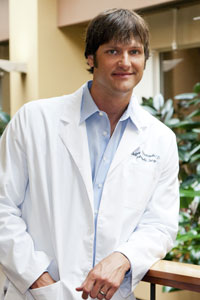Revision Rotator Cuff Surgeon

Are you an athlete who participates in repetitive overhead motions and have had prior rotator cuff surgery? If so, you may be at risk of re injuring your rotator cuff. Arthroscopic revision rotator cuff surgeon, Dr. Jeff Padalecki provides diagnosis and both surgical and nonsurgical treatment options for patients in Austin who are experiencing continued problems withe their rotator cuff. Contact Dr. Padalecki’s team today!
What is an Arthroscopic Revision Rotator Cuff Repair?
The rotator cuff is a series of four muscles that surround the shoulder joint – each one responsible for centering the ball in the socket of the shoulder and providing strength to move the arm and participate in overhead activities. Unfortunately, any of these four muscle-tendon units can become injured. A rotator cuff injury can occur from the natural aging process, during a sports activity or from overuse while on the job. Certain Austin, Round Rock, and Cedar Park, Texas residents will require an arthroscopic shoulder surgery to repair the rotator cuff in order to return full function to the joint. If a patient experiences a rotator cuff repair that hasn’t healed correctly, or has re-torn following surgery, a revision rotator cuff repair may be recommended by Dr. Jeff Padalecki, orthopedic shoulder surgeon.
The muscles that make up the rotator cuff are surrounded and connected by tendons. Individuals who partake in constant shoulder rotations (such as swimmers), who are injured in sports, or those who experience a traumatic injury such as from a fall or accident, risk damaging these tendons. This damage may be in the form of inflammation from overuse or bursitis, or from an impingement. Degenerative wear and tear from chronic overuse can also be the cause for injury. There are a variety of conditions that can occur from damaged rotator cuff muscles-these conditions usually involve a tear in the muscle or tendon. Depending on the exact injury, treatment can help alleviate the pain and restore function to the shoulder joint.
In the case of rotator cuff injuries where a partial tear, or complete tear, of the muscles or tendons exist, surgery is usually needed to correct this injury. Dr. Padalecki typically uses an arthroscopic approach to repair rotator cuff tears. In some circumstances a patient may have a re-tear of the rotator cuff after a previous repair. This is often do to some sort of traumatic occurrence which leads to re-injury (and in many cases, is a sign that the patient may have returned to activities too quickly after the initial surgery.)
In these cases, a revision rotator cuff repair is typically required to provide the patient with an optimal outcome. A revision repair is a more difficult procedure due to the complexity of dealing with a tendon that has now torn multiple times and the fact that a repair has already been completed previously.
How is a Revision Rotator Cuff Repair Performed?
Dr. Padalecki conducts revision rotator cuff repairs via an arthroscopic approach as well. During surgery, his primary focus is to use as much of the healthy tendon as he can and reattach it to its native footprint. Some cases may involve a graft or additional attachment to assist in this process. Dr. Padalecki may also use assisted techniques such as a marrow stimulation healing response or platelet rich plasma.
The revision surgery, and the intricate nature of how it is performed will determine on the exact type of tear or re-tear. In very severe cases involving large, traumatic and chronic re-tears, full repair may not be achievable. These cases are treated with partial repairs, augmentation, or debridement.
What Happens After Revision Rotator Cuff Surgery?
After revision rotator cuff surgery, Dr. Padalecki will prescribe a very detailed, thorough physical therapy and rehabilitation program. The patient’s arm will placed in a sling and therapy will start almost immediately after surgery. The specific progression of rehabilitation will depend on the injury, type of repair, nature of the surgery, age, and overall health of the patient. Initially, the patient will need to remain in the sling for a period of 6-8 weeks. Therapy typically involves passive range of motion moves, followed by active motion, strengthening, and a slow, steady return to activities.
For additional information on a revision rotator cuff repair, or for additional resources on another form of arthroscopic shoulder surgery, please contact the office of Dr. Jeff Padalecki, orthopedic shoulder surgeon in Austin, Texas.